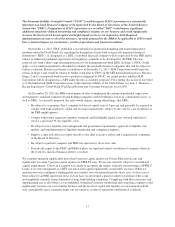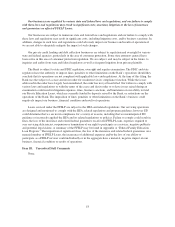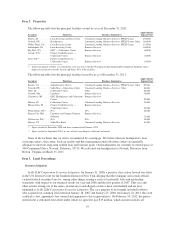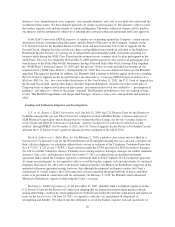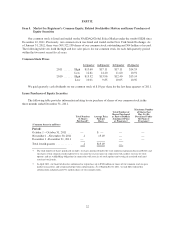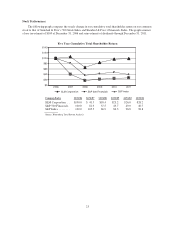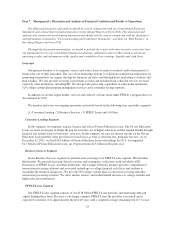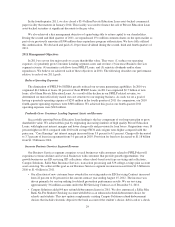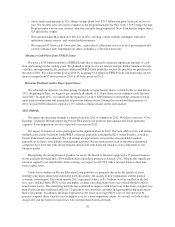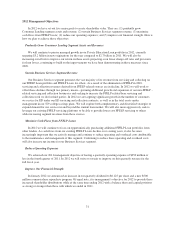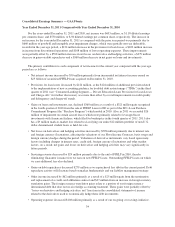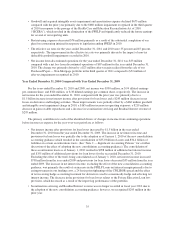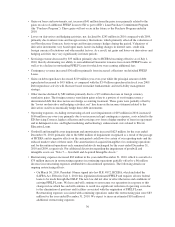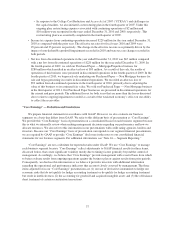Sallie Mae 2011 Annual Report Download - page 29
Download and view the complete annual report
Please find page 29 of the 2011 Sallie Mae annual report below. You can navigate through the pages in the report by either clicking on the pages listed below, or by using the keyword search tool below to find specific information within the annual report.interest even if underlying debt costs decrease. We refer to this additional spread income as “Floor Income”. This
Floor Income can be volatile as rates on underlying debt move up and down. We generally hedge this risk by
selling Floor Income Contracts which lock in the value of the Floor Income over the term of the contract.
Additional cash flow should be generated within this segment as many of our secured financing vehicles are
over-collateralized, creating the potential for additional cash flow to be distributed to us over time as the loans
amortize.
Provisions for Loan Losses
Management estimates and maintains an allowance for loan losses generally at a level sufficient to cover
charge-offs expected over the next two years, plus additional allowance to cover life-of-loan expected losses for
loans classified as a troubled debt restructuring. The provision is an income statement item that reduces segment
revenues. Generally the allowance rises when charge-offs are expected to increase and falls when charge-offs are
expected to decline. Our loss exposure and resulting provision for losses is smaller for FFELP Loans than for
Private Education Loans because we bear a maximum of 3 percent loss exposure on our FFELP Loans whereas
we bear the full credit exposure on our Private Education Loans. Our provision for losses in our FFELP Loans
segment was $86 million in 2011 compared with $98 million in 2010. Losses in our Consumer Lending segment
are primarily driven by risk characteristics such as school type, loan status (in-school, grace, forbearance,
repayment and delinquency), loan seasoning (number of months in active repayment for which a scheduled
payment was due), underwriting criteria (e.g., credit scores), existence or absence of a cosigner and the current
economic environment. Our provision for loan losses in our Consumer Lending segment was $1.2 billion in 2011
compared with $1.3 billion in 2010.
Charge-Offs and Delinquencies
When we conclude a loan is uncollectable, the unrecoverable portion of the loan is charged against the
allowance for loan losses in the applicable lending segment. Information regarding charge-offs provides relevant
information over time with respect to the actual performance of our loan portfolios as compared against the
provisions for loan losses on those portfolios. Management focuses on the overall level of delinquencies as well
as the progression of loans from early to late stage delinquency. The FFELP segment charge-off rate was 0.08
percent of loans in repayment in 2011 compared with 0.11 percent in 2010. The Consumer Lending segment’s
charge-off rate was 3.7 percent of loans in repayment in 2011 compared with 5.0 percent of loans in repayment in
2010. Delinquencies are a very important indicator of the potential future credit performance. Private Education
Loan delinquencies as a percentage of Private Education Loans in repayment decreased from 10.6 percent at
December 31, 2010 to 10.1 percent at December 31, 2011.
Servicing and Contingency Revenues
We earn servicing revenues from servicing student loans, Campus Solutions, and from account asset
servicing related to 529 college-savings plans. We earn contingency revenue related to default aversion and
contingency collections work we perform primarily on federal loans. The fees we recognize are primarily driven
by our success in collecting or rehabilitating defaulted loans, the number of transactions processed and the
underlying volume of loans we are servicing on behalf of others.
Other Income / (Loss)
In managing our loan portfolios and funding sources we periodically engage in sales of loans and the
repurchase of our outstanding debt. In each case, depending on market conditions, we may incur gains or losses
from these transactions that affect our results from operations.
27


